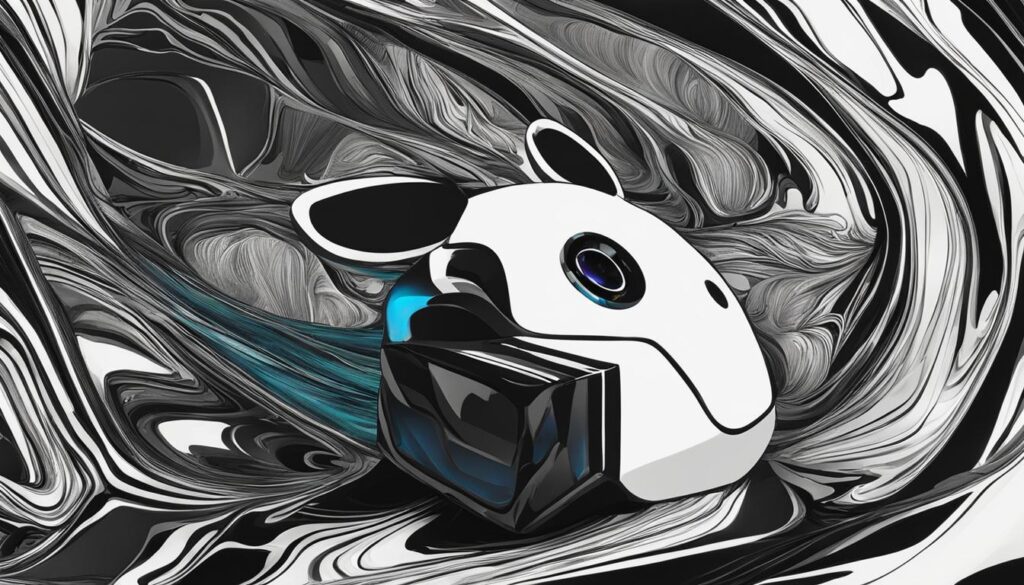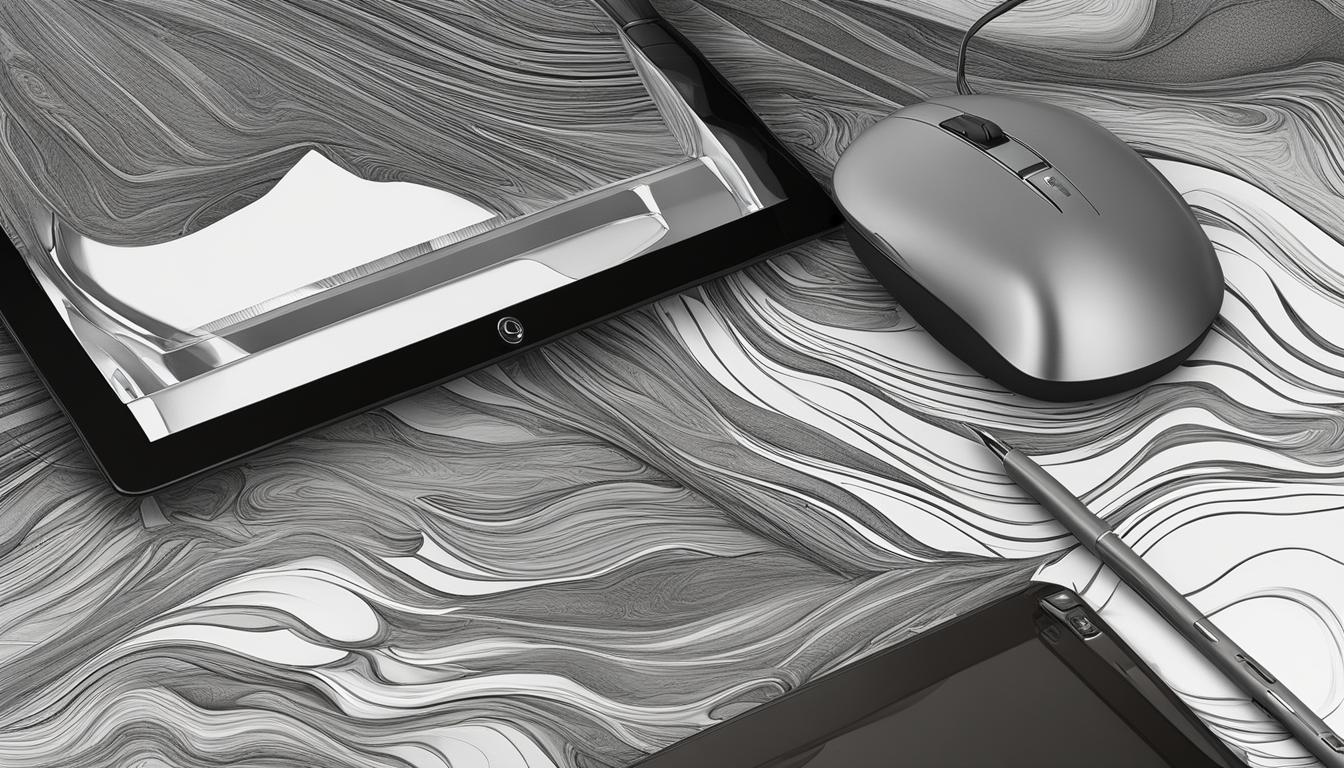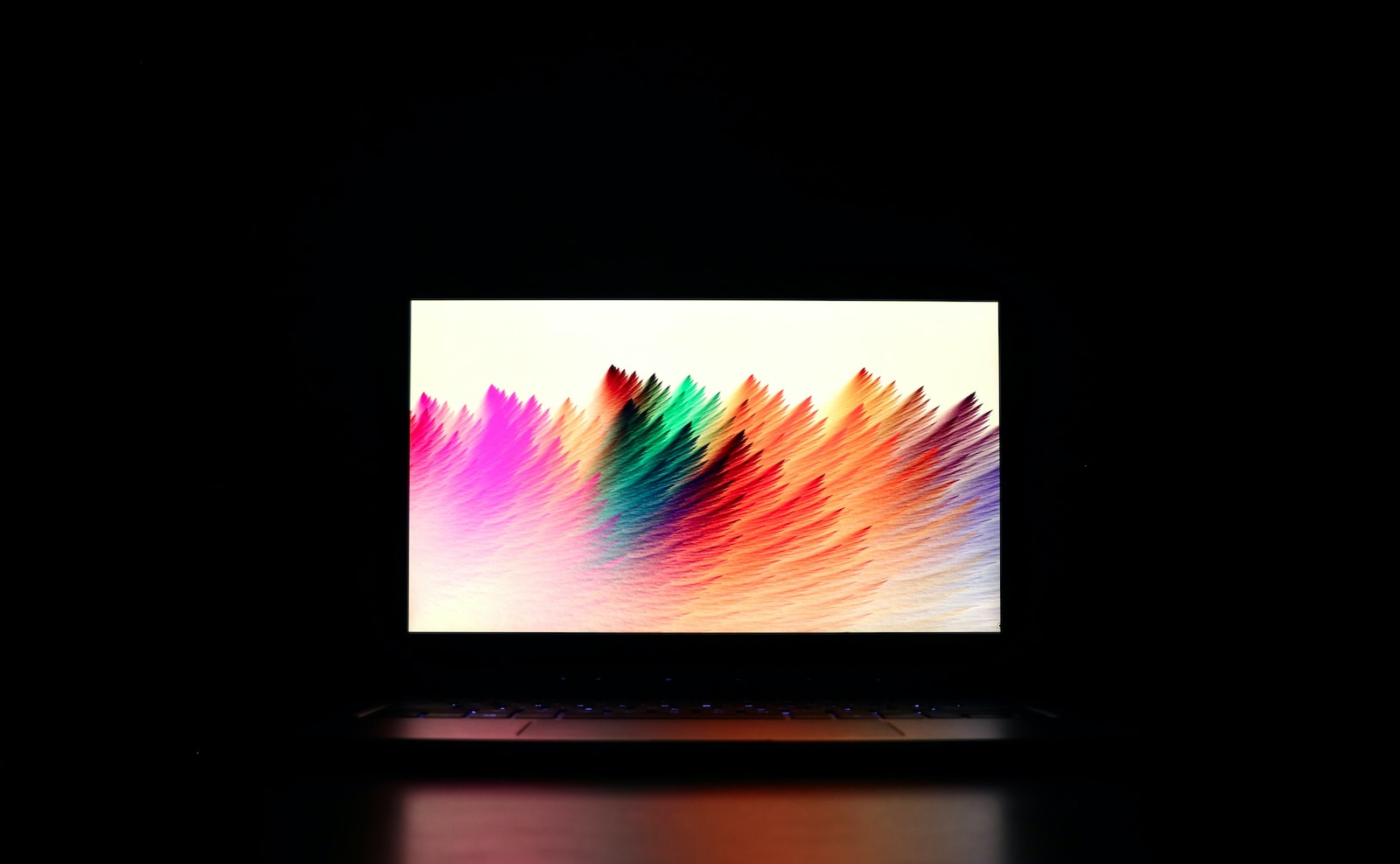In the world of graphic design, digital art tablets and mice are two commonly used tools. While they may seem similar at first glance, there are distinct differences between them that every designer should be aware of. Understanding these differences will help you choose the right tool for your creative needs. In this article, we will explore the differences and compare digital art tablets to mouse design.
Key Takeaways:
- Digital art tablets provide more control, precision, and naturalness in strokes compared to mice.
- Tablets offer features like pressure sensitivity and tilt recognition, enhancing the creative process.
- A mouse is more affordable, accessible, and versatile, making it suitable for a wide range of design tasks.
- Mice lack the natural brush-like strokes and features of tablets, but they are more precise in making fine adjustments and selections.
- The choice between a digital art tablet and a mouse depends on personal preferences, style, goals, and budget.
Advantages of Digital Art Tablets
Using a digital art tablet offers several advantages for graphic designers. One of the key benefits is the ability to draw directly on the screen using a stylus, which mimics the feel of a pen or brush. This provides artists with more control, precision, and naturalness in their strokes, allowing for a more fluid and expressive creative process.
Additionally, digital art tablets often come with features like pressure sensitivity and tilt recognition. These features further enhance the artistic experience by allowing artists to vary the thickness and opacity of their strokes based on the pressure applied. Tilt recognition adds another level of realism, enabling artists to create brush-like effects by tilting the stylus at different angles.
The Advantages of Digital Art Tablets:
- Direct drawing on the screen with a stylus
- More control, precision, and naturalness in strokes
- Pressure sensitivity for varied thickness and opacity
- Tilt recognition for brush-like effects
Another advantage of using a digital art tablet is the ergonomic benefits it offers. Tablets are designed to provide a more comfortable and natural drawing position, reducing the risk of strain or injury. They allow artists to work in a more relaxed posture, which can be especially beneficial during long drawing sessions.
Overall, the advantages of digital art tablets make them an excellent choice for artists looking to enhance their creative process and produce high-quality artwork.
Table: Comparison of Digital Art Tablets and Mice for Graphic Design
| Advantages | Digital Art Tablets | Mice |
|---|---|---|
| Naturalness in strokes | ✅ | ❌ |
| Control and precision | ✅ | ✅ |
| Pressure sensitivity | ✅ | ❌ |
| Tilt recognition | ✅ | ❌ |
| Ergonomics | ✅ | ❌ |
| Affordability | ❌ | ✅ |
| Versatility | ✅ | ✅ |
The table above compares the advantages of digital art tablets and mice for graphic design. While tablets offer superior naturalness in strokes, control and precision, pressure sensitivity, tilt recognition, and ergonomic benefits, mice have advantages in terms of affordability and versatility. The choice between the two ultimately depends on the artist’s specific needs, preferences, and budget.
Benefits of Using a Mouse for Graphic Design
While digital art tablets have their advantages, using a mouse for graphic design also has its benefits. Let’s explore some of the key advantages:
- Accessibility and Affordability: A mouse is a common peripheral device that is widely available and relatively inexpensive. It can be easily connected to any computer or laptop without compatibility issues.
- Versatility: A mouse can be used for various purposes beyond graphic design, such as browsing the internet, navigating software, and general computer usage. It is a versatile tool that can be used in different contexts.
- Precision: When it comes to making fine adjustments and selections, a mouse offers excellent precision. Its cursor allows for accurate positioning and control, making it suitable for detailed graphic design work.
Using a mouse for graphic design does not require a significant learning curve, as it is a familiar tool for most people. It provides a straightforward and intuitive user experience, enabling designers to focus on their creative process without additional technical complexities.
While a mouse may not offer the same level of natural brush-like strokes as a digital art tablet, its accessibility, affordability, versatility, and precision make it a valuable tool for graphic designers.
Note: The image above illustrates the benefits of using a mouse for graphic design.
Drawbacks of Digital Art Tablets
While digital art tablets have numerous advantages, there are also some drawbacks to consider when deciding whether to invest in one.
Table: Comparison Between Digital Art Tablets and Mice
| Drawbacks | Digital Art Tablets | Mice |
|---|---|---|
| Cost | High-quality tablets can be expensive. | Mice are more affordable. |
| Learning Curve | Using a tablet requires adjustment to settings, software, and eye-hand coordination. | Mice are more intuitive and familiar. |
| Portability | Tablets can be less portable than mice. | Mice are highly portable. |
| Compatibility | Tablets may have compatibility or connectivity issues. | Mice have broad compatibility with different devices and software. |
Digital art tablets can have a significant upfront cost, especially for high-quality models with advanced features. Additionally, users may need to invest in additional accessories like stands or cases to fully enjoy the tablet’s capabilities. Furthermore, learning to use a tablet effectively requires time and practice to adjust to the settings, software, and coordination between the eye and hand.
Another drawback of digital art tablets is their potential lack of portability. Compared to mice, which are highly portable and can easily be used with laptops or other devices on the go, tablets can be bulkier and less convenient to carry around. Additionally, tablets may have compatibility or connectivity issues with different devices or platforms, requiring users to troubleshoot or find workarounds.
Despite these drawbacks, many artists and designers find that the benefits of digital art tablets outweigh the challenges. The precise control, natural brush-like strokes, and advanced features offered by tablets can greatly enhance the creative process and result in stunning digital artwork.
Drawbacks of Using a Mouse for Graphic Design
While a mouse is a commonly used tool for graphic design, it does have its drawbacks. Here are some key limitations to consider:
- Lack of Natural Brush-like Strokes: Unlike digital art tablets that offer a pen or brush-like experience, a mouse lacks the ability to produce organic and fluid strokes. This can limit the artistic expression and make it challenging to achieve certain effects or textures.
- Less Intuitive and Expressive: Using a mouse for graphic design relies on clicks and drags, which can be less intuitive and expressive compared to the natural strokes and gestures enabled by a tablet. This may result in a less spontaneous and immersive creative process.
- Time-consuming Workflow: Working with a mouse in graphic design often involves frequent switching between tools and menus. This can slow down the workflow and make certain tasks more time-consuming, especially when it comes to precise adjustments and selections.
- Risk of Strain and Fatigue: Prolonged use of a mouse can lead to repetitive strain injury or carpal tunnel syndrome. The repetitive movements and prolonged screen exposure can also cause eye strain and fatigue, affecting both comfort and productivity.
While a mouse may be a more accessible and versatile option, it’s important to weigh these drawbacks against your specific needs and preferences in graphic design.
Table: Comparison of Digital Art Tablets and Mice for Graphic Design
| Digital Art Tablets | Mice | |
|---|---|---|
| Control and Precision | High | Moderate |
| Natural Strokes and Gestures | Yes | No |
| Intuitiveness | High | Moderate |
| Ergonomics | Good | Depends on the mouse design |
| Accessibility | Lower | Higher |
| Versatility | Moderate | High |
| Price Range | Higher | Lower |
| Learning Curve | Moderate | Low |
| Workflow Efficiency | Depends on the user | Depends on the user |
| Health Risks | Lower | Higher |
Remember, the choice between a digital art tablet and a mouse ultimately depends on your personal preferences, budget, and specific requirements for your graphic design projects. Take the time to experiment, try both options, and find the tool that enhances your creative workflow and helps you achieve the desired artistic results.
Choosing Between a Digital Art Tablet and a Mouse
When it comes to choosing between a digital art tablet and a mouse for graphic design, there are several factors to consider. Your decision should be based on your personal preferences, artistic style, goals, and budget. Both devices have their own unique advantages and drawbacks, so it’s important to weigh them against your specific needs.
If you prioritize control, precision, and natural strokes, then a digital art tablet may be the best choice for you. Tablets allow you to draw directly on the screen with a stylus, mimicking the feel of a pen or brush. They offer features like pressure sensitivity and tilt recognition, enhancing your creative process. Tablets also provide a more ergonomic working posture, reducing the risk of strain or injury.
On the other hand, if affordability, accessibility, and versatility are your main concerns, then using a mouse for graphic design may be a more practical option. Mice are more affordable than tablets and can be used with any computer or software without compatibility issues. They are precise and accurate, making them suitable for making fine adjustments and selections.
Ultimately, the choice between a digital art tablet and a mouse depends on what feels most natural and comfortable to you. It’s recommended to try both options and see which one enhances your design experience and helps you achieve the desired artistic results. Experiment with different tools, consider the type of work you’ll be doing, the software you’ll be using, and the quality of artwork you want to create. Remember, there is no right or wrong answer, as both devices have their own strengths and weaknesses.
| Digital Art Tablet | Mouse | |
|---|---|---|
| Advantages |
|
|
| Drawbacks |
|
|
Personal Experiences with Digital Art Tablets and Mice
When it comes to personal experiences with digital art tablets and mice, there is a wide range of opinions and preferences among artists and designers. Some individuals find that using a digital art tablet provides them with a sense of control, precision, and naturalness in their strokes. The ability to draw directly on the screen with a stylus enables a more tactile and intuitive creative process. Tablets with features like pressure sensitivity and tilt recognition enhance the artistic possibilities and allow for a more expressive outcome.
On the other hand, there are those who prefer using a mouse for their graphic design work. The familiarity, affordability, and versatility of a mouse make it a popular choice. Mice are precise and accurate when it comes to making fine adjustments and selections. They also offer a seamless experience across different software and platforms, without the need for additional compatibility considerations.
Ultimately, personal experiences with digital art tablets and mice depend on individual preferences, artistic style, and workflow. Some artists may enjoy the natural strokes and features provided by a tablet, while others appreciate the convenience and efficiency of using a mouse. It is crucial to experiment with both options and find the tool that suits one’s needs and enhances their creative process.

Although there is no one-size-fits-all answer, artists and designers should consider their unique requirements, budget, and comfort level when choosing between a digital art tablet and a mouse. What matters most is finding the device that allows for the realization of one’s artistic vision and ensures a pleasant and productive design experience.
Table: Comparing Personal Experiences with Digital Art Tablets and Mice
| Aspect | Digital Art Tablets | Mice |
|---|---|---|
| Control and Precision | Provide more control, precision, and natural strokes | Offer precise adjustments and selections |
| Features | Pressure sensitivity, tilt recognition, and stylus input | Click and drag functionality |
| Comfort | Allows for a more ergonomic working posture | No specific ergonomic benefits |
| Accessibility | May have a learning curve and require adjustment | Familiar and intuitive tool for most people |
| Affordability | Can be more expensive, especially high-quality models | Generally more affordable |
| Versatility | May have compatibility or connectivity issues | Compatible with any computer or software |
Note: The table above provides a general overview of the experiences associated with digital art tablets and mice. Individual preferences and needs may vary.
Conclusion
In conclusion, the choice between a digital art tablet and a mouse for graphic design ultimately comes down to personal preferences, style, goals, and budget. Digital art tablets offer more control, precision, and natural strokes with features like pressure sensitivity and tilt recognition. They also provide a more ergonomic working posture and reduce the risk of strain or injury. On the other hand, a mouse is more affordable, accessible, and versatile, and it can be used with any computer or software without compatibility issues.
Both the digital art tablet and the mouse have their advantages and drawbacks. Tablets may require a learning curve and can be less portable, while mice lack the natural brush-like strokes and features of a tablet. However, it is important to try both options and see which one feels more natural, comfortable, and enjoyable for each individual’s artistic style and creative workflow.
Ultimately, there is no right or wrong answer in choosing between a digital art tablet and a mouse. The decision should be based on personal preferences and the specific requirements of the design work. By experimenting and finding the tool that enhances the design experience and creates the desired artistic results, graphic designers can make an informed choice and excel in their creative endeavors.
FAQ
How do digital art tablets differ from mouse design?
Digital art tablets offer more control, precision, and natural strokes with features like pressure sensitivity and tilt recognition. On the other hand, a mouse is more affordable, accessible, and versatile but lacks the natural brush-like strokes and features of a tablet.
What are the advantages of digital art tablets?
Digital art tablets allow users to draw directly on the screen with a stylus, providing more control, precision, and naturalness in strokes. They also offer features like pressure sensitivity and tilt recognition, enhancing the creative process. Additionally, tablets can reduce the risk of strain or injury and provide a more ergonomic working posture.
What are the benefits of using a mouse for graphic design?
A mouse is more affordable, accessible, and versatile compared to a tablet. It can be used with any computer or software without compatibility issues. The mouse is also precise and accurate, making it suitable for making fine adjustments and selections. Additionally, using a mouse does not require a learning curve, as it is a familiar tool for most people.
What are the drawbacks of digital art tablets?
Digital art tablets can be expensive, especially high-quality ones with advanced features. Users may need to invest in additional accessories like stands or cases. Tablets also have a learning curve, requiring adjustment to settings, software, and coordination between eye and hand. Additionally, tablets can be less portable and may have compatibility or connectivity issues with different devices or platforms.
What are the drawbacks of using a mouse for graphic design?
A mouse lacks the natural brush-like strokes and features of a tablet. It can be less intuitive and expressive, relying on clicks and drags instead of natural strokes and gestures. Using a mouse for graphic design can be time-consuming, requiring switching between tools and menus frequently. Prolonged use of a mouse can also lead to repetitive strain injury or carpal tunnel syndrome, as well as eye strain and fatigue from prolonged screen exposure.
How do I choose between a digital art tablet and a mouse?
The choice between a digital art tablet and a mouse depends on personal preferences, style, goals, and budget. It is recommended to try both options and see which one feels more natural, comfortable, and enjoyable. Consider the type of illustration or design work to be done, the software to be used, and the desired quality of the artwork.
What are personal experiences with digital art tablets and mice?
Personal experiences with digital art tablets and mice vary widely. Some users prefer the control, precision, and naturalness of strokes provided by a tablet, while others prefer the affordability, accessibility, and versatility of a mouse. It often comes down to individual preferences and familiarity with the tools. It is important to experiment and find the tool that works best for each individual’s artistic style and creative workflow.
 Skip to main content
Skip to main content


